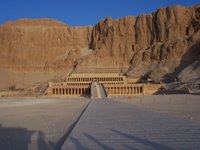by Rosario Charie Albar

According to Patricia Schultz, there are 1000 Places to See Before You Die. Well, I've tried to see as many as I can in 2005 and came home with many beautiful memories of the man made wonders of Egypt, the natural splendor of Yosemite National Park, the lazy days at the Wannsee Lake in Berlin, the gastronomic pilgrimage in Prague and best of all, the warmth and hospitality of old and new friends I met along the way.
Travel is a gift that keeps on giving. A fellow traveler once told me that she is always happy. She is happy during the trip discovering new places and meeting people. When she returns home, she is happy with travel memories and the photographs remind her again and again of the good times she had. This happiness is sustained when she starts planning for her next trip. And then it's time again to embark on another journey. And the cycle continues.
Last night I spoke with a close friend who loves to travel and whom I met on my way to Europe. We live about 30 minutes apart but this year we only saw each other once, at Charles de Gaulle airport in Paris. Imagine, I barely see her here at home because we work and have difficult schedules. But we met by chance halfway across the world. We both realize that we were born with winged feet and we are happiest when we tread and explore unfamiliar territory.
My friend and I talked about our travel plans for 2006. Not surprisingly she's already made reservations at her favorite hotel in Paris after which she'll visit with friends in Brittany. And I shared with her my many travel plans which I hope to fulfill in 2006.
My biggest travel nightmare is deciding where to go next. Just think, there are at least 1000 Places to See plus a few more from my own personal list. The good news is, with these many places to visit, happy days are here to stay.
Wishing you peace, laughter and the gift of travel in 2006.
* * *

According to Patricia Schultz, there are 1000 Places to See Before You Die. Well, I've tried to see as many as I can in 2005 and came home with many beautiful memories of the man made wonders of Egypt, the natural splendor of Yosemite National Park, the lazy days at the Wannsee Lake in Berlin, the gastronomic pilgrimage in Prague and best of all, the warmth and hospitality of old and new friends I met along the way.
Travel is a gift that keeps on giving. A fellow traveler once told me that she is always happy. She is happy during the trip discovering new places and meeting people. When she returns home, she is happy with travel memories and the photographs remind her again and again of the good times she had. This happiness is sustained when she starts planning for her next trip. And then it's time again to embark on another journey. And the cycle continues.
Last night I spoke with a close friend who loves to travel and whom I met on my way to Europe. We live about 30 minutes apart but this year we only saw each other once, at Charles de Gaulle airport in Paris. Imagine, I barely see her here at home because we work and have difficult schedules. But we met by chance halfway across the world. We both realize that we were born with winged feet and we are happiest when we tread and explore unfamiliar territory.
My friend and I talked about our travel plans for 2006. Not surprisingly she's already made reservations at her favorite hotel in Paris after which she'll visit with friends in Brittany. And I shared with her my many travel plans which I hope to fulfill in 2006.
My biggest travel nightmare is deciding where to go next. Just think, there are at least 1000 Places to See plus a few more from my own personal list. The good news is, with these many places to visit, happy days are here to stay.
Wishing you peace, laughter and the gift of travel in 2006.
* * *